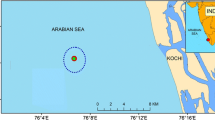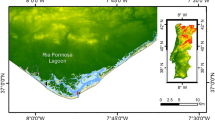Abstract
The aim of this study was to investigate how nutrient limitation in phytoplankton blooms affects growth and C:N:P ratios in marine pelagic copepods. We performed two mesocosm experiments on the Atlantic coast near Trondhjem (Norway). Si-limitation in a phytoplankton bloom was triggered by N and P additions (NP treatment) and N-limitation was triggered by N, P and Si additions (NPSi treatment). Both nutrient treatments stimulated microalgal growth and increased the biomass of the phytoplankton manifold. The initial phytoplankton community consisted of flagellates and diatoms. Throughout both experiments, community composition stayed relatively stable and diverse in the NP treatments, but in the NPSi treatments large and heavily silicified diatoms came to dominate completely. Phytoplankton C:N ratios in the Si-limited blooms were close to the Redfield ratio of 6.6 (on a molar basis), but they were higher in the Control treatment without nutrient additions (ca. 8.6) and up to 14 in heavily N-limited blooms. When phytoplankton blooms (chlorophyll a > 25 nmol l−1) had established, wild copepods were added to the mesocosms. During Si-limitation the copepod density increased by ca. 40% in one of the experiments, while the C:N ratio was 5.5–6 in the copepods. During N-limitation, the copepod density stayed stable, while the C:N ratio increased to ca. 7 in the course of the experiment. In the other experiment the copepod density decreased by ca. 25%, irrespective of nutrient treatment (C:N ratio ca. 9). The N:P ratios in the copepods varied between 16 and 22 and were not different in the NP and NPSi treatments. Our study shows that N-limitation in phytoplankton cells can increase the C:N ratio of their grazers, which has a reportedly negative effect on copepod growth and reproduction. Our study also shows that copepod populations can be regulated by seawater Si:N ratios via diatoms: at high ratios the growth from eggs/nauplii to copepodites was hampered. High Si:N ratios provide diatoms with possibilities to escape from grazing (large species, heavy silicification, excretion of secondary metabolites), leading to the accumulation of algal biomass without transfer to higher trophic levels.
Similar content being viewed by others
References
Andersson, M., L. Van Nieuwerburgh & P. Snoeijs, 2003. Pigment transfer from phytoplankton to zooplankton with emphasis on astaxanthin production in the Baltic Sea food web. Mar. Ecol. Prog. Ser. 254: 213–224.
Ban, S., C. Burns, J. Castel, Y. Chaudron, E. Christou, R. Escribano, S. F. Umani, S. Gasparini, F. G. Ruiz, M. Hoffmeyer, A. Ianora, H. K. Kang, M. Laabir, A. Lacoste, A. Miralto, X. Ning, S. Poulet, V. Rodriguez, J. Runge, J. Shi, M. Starr, S. Uye & Y. Wang, 1997. The paradox of diatom-copepod interactions. Mar. Ecol. Prog. Ser. 157: 287–293.
Brown, M. R., S. W. Jeffrey, J. K. Volkman & G. A. Dunstan, 1997. Nutritional properties of microalgae for mariculture. Aquaculture 151: 315–331.
Caraco, N., J. Cole & G. E. Likens, 1990. A comparison of phosphorous immobilisation in sediments of freshwater and coastal marine waters. Biochemistry 9: 277–290.
Carlsson, P. & E. Granéli, 1999. Effects of N:P:Si ratios and zooplankton grazing on phytoplankton communities in the northern Adriatic Sea. II. Phytoplankton species composition. Aquat. Microb. Ecol. 18: 55–65.
Carrillo, P., M. Villar-Argaiz & J. M. Medina-Sánchez, 2001. Relationships between N:P ratio and growth rate during the life cycle of calanoid copepods: An in situ measurement. J. Plankton Res. 23: 537–547.
Conley, D. J., C. L. Schelske & E. F. Stoermer, 1993. Modification of the biogeochemical cycle of silica with eutrophication. Mar. Ecol. Prog. Ser. 101: 179–192.
Duarte, C. M., S. Agustí & N. S. R. Agawin, 2000. Response of a Mediterranean phytoplankton community to increased nutrient inputs: a mesocosm experiment. Mar. Ecol. Prog. Ser. 195: 61–70.
Egge, J. K. & D. L. Aksnes, 1992. Silicate as regulating nutrient in phytoplankton competition. Mar. Ecol. Prog. Ser. 83: 281–289.
Egge, J. K. & A. Jacobsen, 1997. Influence of silicate on particulate carbon production in phytoplankton. Mar. Ecol. Prog. Ser. 147: 219–230.
Elser, J. J., W. F. Fagan, R. F. Denno, D. R. Dobberfuhl, A. Folarin, A. Nuberty, S. Interlandi, S. S. Kilham, E. McCauley, K. L. Schulz, E. H. Siemann & R. W. Sterner, 2000. Nutritional constraints in terrestrial and freshwater food webs. Nature 408: 578–580.
Evansson, M., E. A. Bornhold, R. H. Goldblatt, P. J. Harrison & A. G. Lewis, 2000. Temporal variation in body composition and lipid storage of the overwintering, subarctic copepod Neocalanus plumchrus in the strait of Georgia, British Columbia (Canada). Mar. Ecol. Prog. Ser. 192: 239–247.
Geider, R. J. & J. La Roche, 2002. Redfield revisited: variability of C:N:P in marine microalgae and its biochemical basis. Eur. J. Phycol. 37: 1–17.
Gismervik, I., 1997. Stoichiometry analysis of some marine planktonic crustaceans. J. Plankton Res. 19: 279–285.
Gismervik, I., Y. Olsen & O. Vadstein, 2002. Micro-and mesozooplankton response to enhanced nutrient input-a mesocosm study. Hydrobiologia 484: 75–87.
Grasshoff, K., 1999. Methods of Seawater Analyses. Wiley-VCH, Cambridge, Weinheim. 600 pp.
Guillard, R. R. L. & J. H. Ryther, 1962. Studies of marine plankton diatoms I. Cyclotella nana Hustedt and Detonula confervacea (Cleve) Gran. Can. J. Microbiol. 8: 229–239.
Hansen, B. W., B. H. Hygum, M. Brozek, F. Jensen & C. Rey, 2000. Food web interactions in a Calanus finmarchicus dominated pelagic ecosystem-a mesocosm study. J. Plankton Res. 22: 569–588.
Hays, G.C., H. Kennedy & B. W. Frost, 2001. Individual variability in diel vertical migration of a marine copepod: why some individuals remain at depth while others migrate. Limnol. Oceanogr. 46: 2050–2054.
Hessen, D. O., 1992. Nutrient element limitation of zooplankton production. Am. Nat. 140: 799–814.
Hillebrand, H., C.-D. Dürselen, D. Kirschtel, U. Pollingher & T. Zohary, 1999. Biovolume calculation for pelagic and benthic microalgae. J. Phycol. 35: 403–424.
Irigoien, X., R. P. Harris, H. M. Verheye, P. Joly, J. Runge, M. Starr, D. Pond, R. Campbell, R. Shreeve, P. Ward, A. N. Smith, H. G. Dam, W. Peterson, V. Tirelli, M. Koski, T. Smith, D. Harbour & R. Davidson, 2002. Copepod hatching success in marine ecosystems with high diatom concentrations. Nature 419: 387–389.
Jónasdóttir, S. H. & T. Kiørboe, 1996. Copepod recruitment and food composition: do diatoms affect hatching success? Mar. Biol. 125: 743–750.
Kiørboe, T., 1989. Phytoplankton growth rate and nitrogen content: implications for feeding and fecundity in a herbivorous copepod. Mar. Ecol. Prog. Ser. 55: 229–234.
Kleppel, G. S., 1993. On the diets of calanoid copepods. Mar. Ecol. Prog. Ser. 99: 183–195.
Kleppel, G. S., D. V. Holliday & R. E. Pieper, 1991. Trophic interactions between copepods and microplankton: A question about the role of diatoms. Limnol. Oceanogr. 36: 172–178.
Koski, M., 1999. Carbon:nitrogen ratios of Baltic Sea copepods-indication of mineral limitation? J. Plankton Res. 21: 1565–1573.
Kristiansen, S. & E. E. Hoell, 2002. The importance of silicon for marine production. Hydrobiol. 484: 21–31.
Lassus, P., G. Arzul, E. Erard-Le Denn, P. Gentien & C. Marcaillou-Le Baut, 1995 (eds). Harmful Marine Algal Blooms. Lavoisier, Paris, 878 pp.
Mauchline, J., 1998. Advances in marine Biology. The Biology of the Calanoid Copepods. Academic Press, London, 710 pp.
Miralto, A., G. Barone, G. Romano, S. A. Poulet, A. Ianora, G. L. Russo, I. Buttino, G. Mazzarella, M. Laabir, M. Cabrini & M. G. Giacobbe, 1999. The insidious effect of diatoms on copepod reproduction. Nature 402: 173–176.
Nejstgaard, J. C., B. G. Hygum, L.-J. Naustvoll & U. Båmstedt, 2001. Zooplankton growth, diet and reproductive success compared in simultaneous diatom-and flagellate microzooplanktondominated plankton blooms. Mar. Ecol. Prog. Ser. 221: 77–91.
Officer, C. B. & J. H. Ryther, 1980. The possible importance of silicon in marine eutrophication. Mar. Ecol. Prog. Ser. 3: 83–91.
Pertola, S., M. Koski & M. Viitasalo, 2002. Stoichiometry of mesozooplankton in N-and P-limited areas of the Baltic Sea. Mar. Biol. 140: 425–434.
Prins, T. C., V. Escaravage, L. P. M. J. Wetsteyn, J. C. H. Peeters & A. C. Smaal, 1999. Effects of different N-and P-loading on primary and secondary production in an experimental marine ecosystem. Aquatic Ecology 33: 65–81.
Redfield, A. C., B. H. Ketchum & F. A. Richards, 1963. The influence of organisms on the composition of seawater. In Hill, M. N. (ed.), The Sea, Vol. 2. Interscience Publishers, New York: 26–77.
Smayda, T. J., 1990. Novel and nuisance phytoplankton blooms in the sea: evidence for a global epidemic. In Granéli, E., B. Sundström, L. Edler & D. M. Anderson (eds). Toxic Marine Phytoplankton. Elsevier, Amsterdam: 29–41.
Smith, V. H., G. D. Tilman & J. C. Nekola, 1999. Eutrophication: impacts of excess nutrient inputs on freshwater, marine, and terrestrial ecosystems. Envir. Pollut. 100: 179–196.
Snoeijs, P., 1998. Diatoms and environmental change in brackish waters. In Stoermer, E. F. & J. P. Smol (eds), The Diatoms: Applications to the Environmental and Earth Sciences. Cambridge University Press, Cambridge: 298–333.
Snoeijs, P., S. Busse & M. Potapova, 2002. The importance of diatom cell size in community analysis. J. Phycol. 38: 265–272.
Sterner, R. W. & D. O. Hessen, 1994. Algal nutrient limitation and the nutrition of aquatic herbivores. Annu. Rev. Ecol. Syst. 25: 1–29.
Strom, S. L. & N. A. Welschmeyer, 1991. Pigment-specific rates of phytoplankton growth and microzooplankton grazing in the open subarctic Pacific Ocean. Limnol. Oceanogr. 36: 50–63.
Tang, K. W. & H. G. Dam, 2001. Phytoplankton inhibition of copepod egg hatching: test of an exudate hypothesis. Mar. Ecol. Prog. Ser. 209: 197–202.
Tomas, C. R., 1997. Identifying Marine Phytoplankton. Academic Press, London, 858 pp.
Turner, J. T., P. A. Tester, L. A. Lincoln, P. Carlsson & E. Granéli, 1999. Effects of N:P:Si ratios and zooplankton grazing on phytoplankton communities in the northern Adriatic Sea. III. Zooplankton populations and grazing. Aquat. Microb. Ecol. 18: 37–54.
Turner, R. E., N. Qureshi, N. N. Rabalais, Q. Dortch, D. Justic, R. F. Shaw & J. Cope, 1998. Fluctuating silicate:nitrate ratios and coastal plankton food webs. Proc. Natl. Acad. Sci. USA 95: 13048–13051.
Utermöhl, H., 1931. Neue Wege in der quantitativen Erfassung des Planktons (Mit besonderer Berücksichtigung des Ultraplanktons). Verh. Int. Ver. Limnol. 5: 567–596.
Walve, J & U. Larsson, 1999. Carbon, nitrogen and phosphorus stoichiometry of crustacean zooplankton in the Baltic Sea: implications for nutrient recycling. J. Plankt. Res. 21: 2309–2321.
Wright, S. W. & S. W. Jeffrey, 1997. High-resolution HPLC system for chlorophylls and carotenoids of marine phytoplankton. In Jeffrey, S. W., R. F. C. Mantoura & S. W. Wright (eds), Phytoplankton Pigments in Oceanography: Guidelines to Modern Methods. Unesco, Paris: 327–341.
Wright, S. W., S. W. Jeffrey & R. F. C. Mantoura, 1997. Evaluation of methods and solvents for pigment extraction. In Jeffrey, S. W., R. F. C. Mantoura & S. W. Wright (eds), Phytoplankton Pigments in Oceanography: Guidelines to Modern Methods. Unesco, Paris: 261–282.
Author information
Authors and Affiliations
Rights and permissions
About this article
Cite this article
Van Nieuwerburgh, L., Wänstrand, I. & Snoeijs, P. Growth and C:N:P ratios in copepods grazing on N- or Si-limited phytoplankton blooms. Hydrobiologia 514, 57–72 (2004). https://doi.org/10.1023/B:hydr.0000018206.02271.2b
Issue Date:
DOI: https://doi.org/10.1023/B:hydr.0000018206.02271.2b




